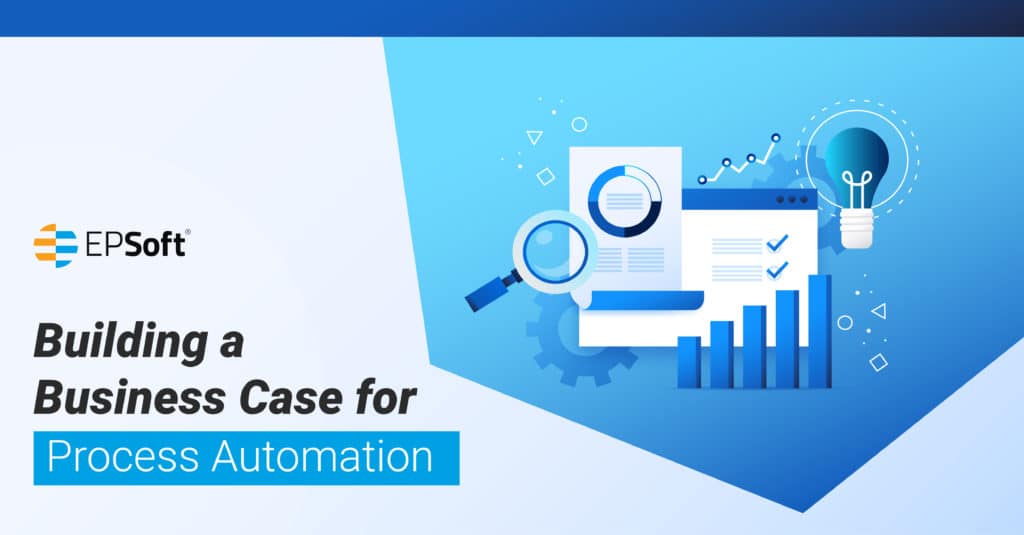Modern businesses need solutions that drive measurable value. When it comes to technology, the stakes are even higher. Before considering any new implementations, today’s leaders need to see the potential for clear, business-specific value-adds. And with good reason! Technology can be a big-ticket investment, and change is hard. If you’re making that kind of investment, it must be worth it.
Enter: The Business Case. The business case is your chance to build a persuasive argument for what is worth it—your professional argument for why your organization should capitalize on a given opportunity. Today we’re going to look at building a business case for process automation and business process management. For today’s exercise, we’re assuming you’ve already researched and found your preferred vendor. If you haven’t yet, we can help! Make the decision easier with a custom process workshop that includes a vendor comparison to help you evaluate your options. Let’s take a look at what comes next.
Building a Business Case for Process Automation
Building your business case is like a general sales process. You’ll need to pitch your solution, educate your audience, and close them on the idea of investing in your proposal. Before you start writing your business case, you’ll need to get all the pieces in place.
-
1. Identify the Pain Points
As with any sales pitch, you’ll need to demonstrate the need. What’s the biggest problem(s) you’re trying to solve? How do these problems inhibit or delay broader company goals? Tell your story with numbers and data, and support your position with unobjectionable facts.For process automation, we might find opportunities within the business processes themselves. Look within these existing company processes to spotlight the obvious measurable inefficiencies. Maybe days payable outstanding (DPO) metrics are running longer in recent years. Maybe order fulfillment has glaring snags. Find the measurable instances in your company and spotlight them. With Process Intelligence you’ll gain the added value of automating this discovery across all your processes to get deeper knowledge on what to fix and why.
-
2. Outline the Benefits
Pull together marketing copy, white papers, stats and case studies. Find all the supporting documentation for how your proposed product will benefit the organization. Dig deep for meaningful factors that can scale and proven statistics that tell your story. Like this stat: It takes an average of 23 minutes to refocus after interruptions at work. Multiply that times every employee and interruptions, and the ROI conversation starts to emerge. How much money will you be saving in time alone?Aside from solving the problems at hand, process automation with Process Intelligence also delivers time and cost savings, simplified resource planning, data-driven decision making, end-to-end efficiencies and more.
-
3. Establish the Known Risks
Look all the way around your opportunity to find the risks and put them on paper. These might include costs, time investment, training, and the like. By knowing what you face, you can avoid technical debt (a technology investment that doesn’t reap the purported benefits). Other risks can be specific to your company or industry. Look at them honestly and account for them within your business case. Once you know the risks, you can adequately plan for them.
With these key elements established, you should have the fundamentals to begin writing your business case. Use data and numbers wherever you can to support your case—financial metrics can be particularly compelling. And use persuasive language as appropriate.
Every case will vary depending on the business and the marketplace, but here is a basic business case outline for process automation.
| Executive Summary | This is your elevator pitch. Sum up your efficiency challenges, your process automation solution and supporting points in a few paragraphs or less. |
| The Challenge | Detail your efficiency challenges. Pull from the data you’ve already collected to show gaps in resources, costs for manual processes, and other metrics that demonstrate the opportunity for improvement. |
| The Proposed Solution | Detail your process automation solution. Spell out the benefits you previously outlined, connecting them to potential use cases within your organization if possible. |
| Financial Analysis | Estimate the total costs for your proposed process automation implementation, including training and any ongoing support and maintenance. Compare this with expected financial benefits to build an equation for ROI. |
| Risk Assessment | Describe any known risks you found during your discovery, and include any mitigating factors you recommend. For example, if the risk is disruption from implementation, you might demonstrate your proposed vendor’s track record for integration, training and support. If your risk is a prolonged investment period, you might point to the long-term time savings. Acknowledge your risks honestly, but think critically about how to manage them. |
| Competitive Market Analysis | Compare your proposed process automation platform with other marketplace options, highlighting why your choice is the winner. Sometimes vendors will have supporting documentation for this (and you likely did this background research when you began looking for solutions). |
| Timeline for Implementation | Finally, map out a basic timeline for integration. Talk to your process automation experts, who can help you build a realistic project timeline for running your first automations. Be sure to include a generalized “future state,” which will provide space in the plan for more advanced automations. |
Process automation can be a game-changer for business efficiency. By building a proper business case, you can see how the benefits of process automation can apply directly to your organization’s goals—and win over stakeholders in the process.
Are you building your own business case for process automation? We can help with that! Get a custom demo and talk to our business process experts today about your vision.

